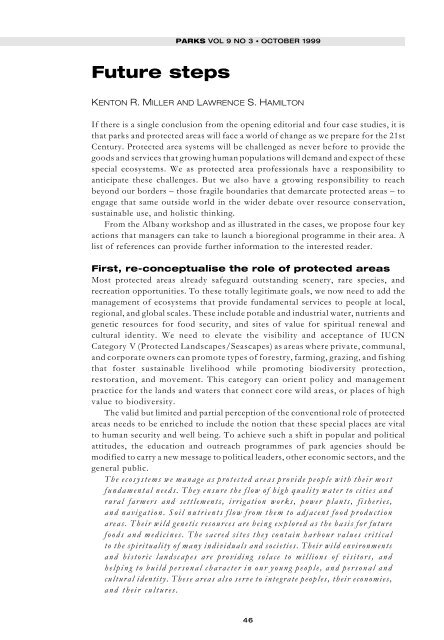Parks - IUCN
Parks - IUCN
Parks - IUCN
You also want an ePaper? Increase the reach of your titles
YUMPU automatically turns print PDFs into web optimized ePapers that Google loves.
Future steps<br />
PARKS VOL 9 NO 3 • OCTOBER 1999<br />
KENTON R. MILLER AND LAWRENCE S. HAMILTON<br />
If there is a single conclusion from the opening editorial and four case studies, it is<br />
that parks and protected areas will face a world of change as we prepare for the 21st<br />
Century. Protected area systems will be challenged as never before to provide the<br />
goods and services that growing human populations will demand and expect of these<br />
special ecosystems. We as protected area professionals have a responsibility to<br />
anticipate these challenges. But we also have a growing responsibility to reach<br />
beyond our borders – those fragile boundaries that demarcate protected areas – to<br />
engage that same outside world in the wider debate over resource conservation,<br />
sustainable use, and holistic thinking.<br />
From the Albany workshop and as illustrated in the cases, we propose four key<br />
actions that managers can take to launch a bioregional programme in their area. A<br />
list of references can provide further information to the interested reader.<br />
First, re-conceptualise the role of protected areas<br />
Most protected areas already safeguard outstanding scenery, rare species, and<br />
recreation opportunities. To these totally legitimate goals, we now need to add the<br />
management of ecosystems that provide fundamental services to people at local,<br />
regional, and global scales. These include potable and industrial water, nutrients and<br />
genetic resources for food security, and sites of value for spiritual renewal and<br />
cultural identity. We need to elevate the visibility and acceptance of <strong>IUCN</strong><br />
Category V (Protected Landscapes/Seascapes) as areas where private, communal,<br />
and corporate owners can promote types of forestry, farming, grazing, and fishing<br />
that foster sustainable livelihood while promoting biodiversity protection,<br />
restoration, and movement. This category can orient policy and management<br />
practice for the lands and waters that connect core wild areas, or places of high<br />
value to biodiversity.<br />
The valid but limited and partial perception of the conventional role of protected<br />
areas needs to be enriched to include the notion that these special places are vital<br />
to human security and well being. To achieve such a shift in popular and political<br />
attitudes, the education and outreach programmes of park agencies should be<br />
modified to carry a new message to political leaders, other economic sectors, and the<br />
general public.<br />
The ecosystems we manage as protected areas provide people with their most<br />
fundamental needs. They ensure the flow of high quality water to cities and<br />
rural farmers and settlements, irrigation works, power plants, fisheries,<br />
and navigation. Soil nutrients flow from them to adjacent food production<br />
areas. Their wild genetic resources are being explored as the basis for future<br />
foods and medicines. The sacred sites they contain harbour values critical<br />
to the spirituality of many individuals and societies. Their wild environments<br />
and historic landscapes are providing solace to millions of visitors, and<br />
helping to build personal character in our young people, and personal and<br />
cultural identity. These areas also serve to integrate peoples, their economies,<br />
and their cultures.<br />
46

















